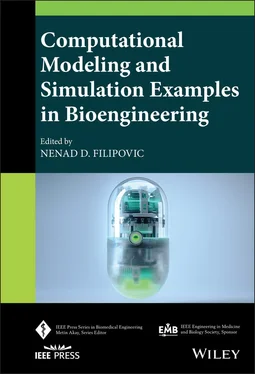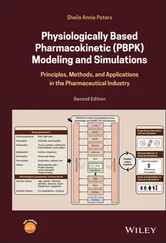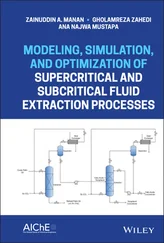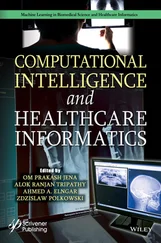Computational Modeling and Simulation Examples in Bioengineering
Здесь есть возможность читать онлайн «Computational Modeling and Simulation Examples in Bioengineering» — ознакомительный отрывок электронной книги совершенно бесплатно, а после прочтения отрывка купить полную версию. В некоторых случаях можно слушать аудио, скачать через торрент в формате fb2 и присутствует краткое содержание. Жанр: unrecognised, на английском языке. Описание произведения, (предисловие) а так же отзывы посетителей доступны на портале библиотеки ЛибКат.
- Название:Computational Modeling and Simulation Examples in Bioengineering
- Автор:
- Жанр:
- Год:неизвестен
- ISBN:нет данных
- Рейтинг книги:3 / 5. Голосов: 1
-
Избранное:Добавить в избранное
- Отзывы:
-
Ваша оценка:
- 60
- 1
- 2
- 3
- 4
- 5
Computational Modeling and Simulation Examples in Bioengineering: краткое содержание, описание и аннотация
Предлагаем к чтению аннотацию, описание, краткое содержание или предисловие (зависит от того, что написал сам автор книги «Computational Modeling and Simulation Examples in Bioengineering»). Если вы не нашли необходимую информацию о книге — напишите в комментариях, мы постараемся отыскать её.
Computational Modeling and Simulation Examples in Bioengineering
Computational Modeling and Simulation Examples in Bioengineering:
Computational Modeling and Simulation Examples in Bioengineering
Computational Modeling and Simulation Examples in Bioengineering — читать онлайн ознакомительный отрывок
Ниже представлен текст книги, разбитый по страницам. Система сохранения места последней прочитанной страницы, позволяет с удобством читать онлайн бесплатно книгу «Computational Modeling and Simulation Examples in Bioengineering», без необходимости каждый раз заново искать на чём Вы остановились. Поставьте закладку, и сможете в любой момент перейти на страницу, на которой закончили чтение.
Интервал:
Закладка:
Prof. Nenad D. Filipovic
Faculty of Engineering,
University of Kragujevac,
SERBIA
1 Computational Modeling of Abdominal Aortic Aneurysms
Nenad D. Filipovic1,2
1Faculty of Engineering, University of Kragujevac, Kragujevac, Serbia
2Bioengineering Research and Development Center, BioIRC, Kragujevac, Serbia
1.1 Background
Abdominal aortic aneurysm (AAA) is a dilation of the aorta beyond 50% of the normal vessel diameter [1] that is frequently observed in the aging population [2] and it affects 6–9% of the people in the industrialized world. It is a major health problem that typically affects men after the age of 50 [3] and it is the thirteenth leading cause of death in Western societies [4]. AAAs cause about 15 000 deaths per year in the United States only [5], and 1.3% of all deaths among men aged 65–85 years in developed countries [6–8]. In the United States alone, 1.5 million have undiagnosed AAAs [3]. They can remain asymptomatic for most of their development and, if left untreated, they can enlarge and eventually rupture with catastrophic mortality rate of 80% [9] to 90% [2]. On the other hand, the mortality following elective AAA repair has significantly improved to 3–6% [10] which clearly demonstrates the need of diagnosing and monitoring AAAs on time in order to make progress in both medical and economic domain.
A myriad of different factors are established in the literature to account for AAA formation, expansion, and, eventually, rupture. Namely, a substantial amount of research on AAA expansion and rupture focuses on different biological and biomechanical factors and, lately, special attention is put to genes and chemical influences. Among biological factors and risk factors, authors usually discuss the influence of diameter, sex, blood pressure, chronic obstructive pulmonary disease, and smoking [11]. From a biomechanical point of view, major factors contributing to AAA expansion and rupture are the wall stress [12, 13] and strength [14], wall stiffness [15], vessel asymmetry [16–19], intraluminal thrombus (ILT) [20, 21], entire geometry [22, 23], etc. Namely, according to the biomechanical perspective, AAA rupture is usually defined as a material failure of the degenerated AAA wall to withstand the stress exerted on it [24]. However, the relationship between rupture and biomechanics of aorta proved to be more complex [10] and the evaluation based only on one of these parameters is not sufficient.
For many years, diameter was taken to be the primary parameter associated with rupture risk estimation. Namely, the threshold of ≥5.5 cm 3was applied as indicative for AAA repair [10]. However, continuous studies in the past showed that while 10–24% of small aneurysms (<5.5 cm) may rupture [1], aneurisms which diameter exceeds the threshold remain stable. These findings cast doubt over the suitability of surgical repair based solely on the maximum diameter criterion [16–18]. In order to refute “diameter criterion” rule, many other criteria and parameters ensued. In contrast, the survey conducted in 2006 [25] confirmed that 92% of surgeons still use maximum diameter criterion and growth rate in making decisions about the surgical intervention while 19% of them stated that they were not even aware that biomechanics may influence the rupture risk. The results of the survey suggest that cooperation of surgeons and engineers is necessary in order not just to make technical advances but to implement them in practice.
Mutual collaboration of clinicians and engineers resulted in different efforts and methodologies proposed in the last few decades, all striving to make progress in the domain of AAA expansion and rupture prediction. This paper reviews some of the most significant studies in the area of AAA modeling in the past decades which further understanding of utmost importance for making additional progress toward validation and application in the clinical setting. We firstly described computational methods applied for AAA in chronological order. Then, different experimental testing as well as our own testing is described in order to determine the mechanical properties of AAA. Mechanical–chemical including ILT modeling is separately analyzed. Finite element procedure including fluid–structure interaction (FSI) from our group is described. In the end, some of data mining (DM) approach and vision for future clinical decision support system (DSS) is given.
1.2 Clinical Trials for AAA
The known risk factors for AAA include male sex, smoking, hypertension, and a family history of AAA in a first‐degree relative [26]. Many clinical studies confirmed that smoking is the most important modifiable risk factor for AAA [27–33]. Some authors discovered that the duration of smoking and daily cigarette number are also associated with a higher risk of AAA [28, 34]. One large systematic review of studies evaluating smoking and aortic aneurysm placed the relative risk of aortic aneurysm‐related events in current smokers between 3 and 6 [34]. Smoking contributes significantly to the prevalence of AAA and may account for 75% of all AAA, 4 cm in diameter or larger [33].
A history of hypertension and myocardial infarction or coronary artery bypass surgery was negatively associated, whereas a body mass index ≥25 kg/m 2was protective [35].
1.3 Computational Methods Applied for AAA
The study of Darling et al. [36] was one of the first studies to conclude that AAA rupture predominately occurs on posterior walls. Namely, in the autopsy study conducted almost 40 years ago on AAA patients, among whom 473 died with surgically intact arteriosclerotic AAAs, it was reported that 82% of ruptures occurred along the posterior and posteriolateral wall of AAA. Consequently, it was important to examine the wall stress acting on these regions in AAA, so that many studies were influenced to direct their research toward examining posterior wall stress for clinical relevance. One of the first studies to apply the finite element analysis (FEA) to determine the AAA wall stress was the study of [37] who concluded that FEA has a potential of becoming a crucial tool in the study of vascular mechanics. Their study was followed by extensive research in the area of numerically predicted AAA wall stress that continues even at present. However, limitations of this study include the use of idealized models with regular structures and evenly distributed wall stress.
In 1998, Vorp et al. [38] published a study on the influence of maximum diameter and aortic aneurysm asymmetry on mechanical wall stress. They investigated the effects of asymmetry on 3D stress distribution in the wall of AAA and refuted the critical diameter criterion suggesting that all AAAs with the same diameter have the same risk of rupture. They generated 10 virtual computer models with commercial software (Pro‐Engineer v. 16.0; Parametric Technology Waltham, Mass) according to two protocols. In the first protocol, five models were generated with constant maximum diameter parameter (6 cm) while asymmetry β varied from 0.3 to 1.0. In the second protocol, asymmetry was kept constant β = 0.4 while maximum diameter parameter varied from 4 to 8 cm. The results confirmed that both parameters had the influence on the increase and decrease in the wall stress in the different sections of the aneurisms and that aneurysm rupture was caused by a gross mechanical failure of the aortic wall which occurs when wall stress exceeds the strength of the tissue. It was also concluded that maximum stress occurs on the posterior wall for small AAAs (≤5), while for larger AAAs peak stress is on the anterior surface. Although it pioneered in proving the effects of asymmetry, the study was performed on virtual models, so potential limitations assuming that AAA wall is homogenous, isotropic, and linearly elastic with small strains and uniform thickness have to be taken into account when analyzing real AAA models.
Читать дальшеИнтервал:
Закладка:
Похожие книги на «Computational Modeling and Simulation Examples in Bioengineering»
Представляем Вашему вниманию похожие книги на «Computational Modeling and Simulation Examples in Bioengineering» списком для выбора. Мы отобрали схожую по названию и смыслу литературу в надежде предоставить читателям больше вариантов отыскать новые, интересные, ещё непрочитанные произведения.
Обсуждение, отзывы о книге «Computational Modeling and Simulation Examples in Bioengineering» и просто собственные мнения читателей. Оставьте ваши комментарии, напишите, что Вы думаете о произведении, его смысле или главных героях. Укажите что конкретно понравилось, а что нет, и почему Вы так считаете.












